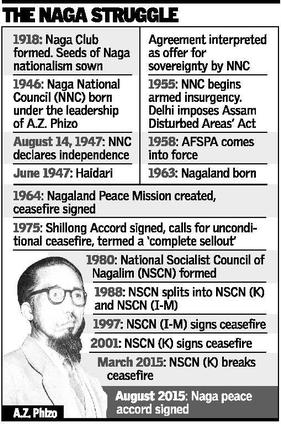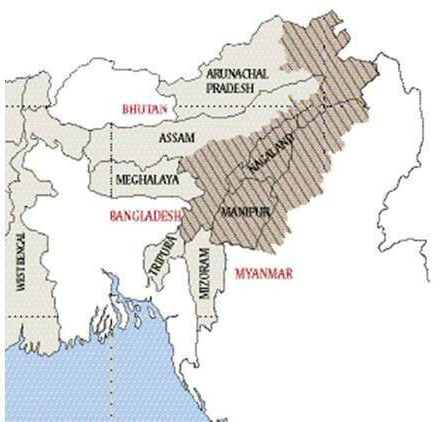Naga Peace Talks | 12 Jul 2021
Why in News
Recently, the Nagaland Government appealed to all Naga political groups and extremist groups to cooperate in establishing unity, reconciliation and peace in the region.
- The peace process between the central government and two sets of the Naga extremist groups has been delaying for more than 23 years.
Nagas
- Nagas are a hill people who are estimated to number about 2.5 million (1.8 million in Nagaland, 0.6 million in Manipur and 0.1 million in Arunachal states) and living in the remote and mountainous country between the Indian state of Assam and Burma.
- There are also Naga groups in Burma.
- The Nagas are not a single tribe, but an ethnic community that comprises several tribes who live in the state of Nagaland and its neighbourhood.
- Nagas belong to the Indo-Mongoloid Family.
- There are nineteen major Naga tribes, namely, Aos, Angamis, Changs, Chakesang, Kabuis, Kacharis, Khain-Mangas, Konyaks, Kukis, Lothas (Lothas), Maos, Mikirs, Phoms, Rengmas, Sangtams, Semas, Tankhuls, Yamchumgar and Zeeliang.
Key Points
- Background of Naga Insurgency:

- The Naga Hills became part of British India in 1881.
- The effort to bring scattered Naga tribes together resulted in the formation of the Naga Club in 1918.
- The club aroused a sense of Naga nationalism.
- The club metamorphosed into the Naga National Council (NNC) in 1946.
- Under the leadership of Angami Zapu Phizo, the NNC declared Nagaland as an independent State on 14th August, 1947, and conducted a “referendum” in May 1951 to claim that 99.9% of the Nagas supported a “sovereign Nagaland”.
- Nagaland achieved statehood in December 1963. Nagaland was formed out of the Naga Hills district of Assam and the then North East Frontier Agency (NEFA) province (now Arunachal Pradesh).
- In 1975, under the Shillong Accord, some factions of NNC and NFG (Naga Federal Government) agreed to give up arms.
- A group of about 140 members led by Thuingaleng Muivah, who was at that time in China, refused to accept the Shillong Accord and formed the National Socialist Council of Nagaland (NSCN) in 1980.
- In 1988, the NSCN split into NSCN (IM) and NSCN (K) after a violent clash.
- While the NNC began to fade away, and Phizo died in London in 1991, the NSCN (IM) came to be seen as the “mother of all insurgencies” in the region.
- Demands of Naga Groups:
- The key demand of Naga groups has been a Greater Nagalim (sovereign statehood) i.e redrawing of boundaries to bring all Naga-inhabited areas in the Northeast under one administrative umbrella.
- It includes various parts of Arunachal Pradesh, Manipur, Assam and Myanmar as well.
- The demand also includes the separate Naga Yezabo (Constitution) and Naga national flag.
- The key demand of Naga groups has been a Greater Nagalim (sovereign statehood) i.e redrawing of boundaries to bring all Naga-inhabited areas in the Northeast under one administrative umbrella.
- Peace Initiatives:
- Shillong Accord (1975): A peace accord was signed in Shillong in which the NNC leadership agreed to give up arms.
- However, several leaders refused to accept the agreement, which led to the split of NNC.
- Ceasefire Agreement (1997): The NSCN-IM signed a ceasefire agreement with the government to stop attacks on Indian armed forces. In return, the government would stop all counter-insurgency offensive operations.
- Framework Agreement (2015): In this agreement, the Government of India recognised the unique history, culture and position of the Nagas and their sentiments and aspirations.
- Recently, the State government decided to prepare the Register of Indigenous Inhabitants of Nagaland but later due to pressure from various fractions, the decision was put on hold.
- Shillong Accord (1975): A peace accord was signed in Shillong in which the NNC leadership agreed to give up arms.
- Issues:
- The 2015 agreement apparently made the peace process inclusive but it created suspicion about the central government exploiting divisions within the Nagas on tribal and geopolitical lines.
- The issue of integration of contiguous Naga-inhabited areas of Manipur, Assam and Arunachal Pradesh in view of the demand for territorial unification of ‘Greater Nagalim’ will trigger violent clashes in the different affected states.
- Another major hindrance to the peace process in Nagaland is the existence of more than one organisation, each claiming to be representative of the Nagas.
Way Forward
- The Centre must negotiate with all the factions and groups of the Insurgents to have a long-lasting peace. Further, their cultural, historical and territorial extent must be taken into consideration.
- Any arrangement to be worked out should lead to social and political harmony, economic prosperity and protection of the life and property of all tribes and citizens of the states.
- Another way of dealing with the issue can be maximum decentralisation of powers to the tribal heads and minimum centralisation at the apex level, which should mainly work towards facilitating governance and undertaking large development projects.
- Greater autonomy for the Naga inhabited areas in these states can be provided which would encompass separate budget allocations for the Naga inhabited areas with regard to their culture and development issues.
- Moreover, the Centre must keep in mind that most of the armed insurgencies across the world do not end in either total victory or comprehensive defeat, but in a grey zone called ‘compromise’.

